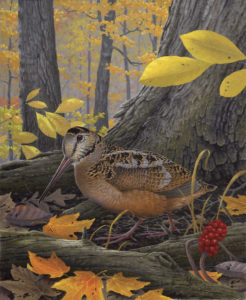BY Lee McClellan
(July 21, 2016) – Although Kentucky is baking in the hottest temperatures of the year, hunters will be afield in a little over a month pursuing migratory birds such as dove, wood duck, American woodcock and resident Canada goose.

Those planning to hunt during these seasons must be aware of some significant changes for the September Canada goose and American woodcock seasons.
The September Canada goose season historically ran during the first two weeks of September, but will open Sept. 16 and close Sept. 30 in 2016.
“It wasn’t an option before, we could only have the September Canada goose season in the first two weeks of September,” said John Brunjes, migratory bird coordinator for the Kentucky Department of Fish and Wildlife Resources. “The Mississippi Flyway Council recently changed our goose management plan and we can now have the season anytime in September.”
Brunjes and other Kentucky Fish and Wildlife staff gathered feedback from waterfowl hunters regarding their date preference for the September Canada goose season.
“The overwhelming majority wanted the season in the last two weeks of September,” Brunjes explained. “Farmers across Kentucky usually have not cut silage yet during the first two weeks of September, but they usually do cut it by the last two weeks of the month. This gives hunters a better chance at harvesting geese in fields.”
Brunjes also noted hunters enjoying the September wood duck and teal seasons may now also harvest a Canada goose if one comes into range.
“Opening on Sept. 1 gets crowded with the dove season opener and other seasons,” Brunjes said. “Separating these seasons out keeps hunters from trying to do three things at once.”
The American woodcock season also changed for 2016. Previously, the season opened Nov. 1 and closed Dec. 15. It will be a split season in 2016, with the American woodcock season closing for the opening weekend of modern gun deer season. The first segment opens Oct. 22 and closes Nov. 11. The second opens Nov. 14 and closes Dec. 7.
“We sent surveys to over 500 known woodcock hunters asking them what they wanted in a season,” Brunjes said. “After gathering their input, combined with the desires of the woodcock hunters who attended the March Kentucky Fish and Wildlife Commission meeting, the Commission decided to recommend these season dates.”
The earlier dates better correspond with peak migration of American woodcock through Kentucky.
This is also the second year of the Habitat Information Program, or H.I.P., a survey implemented last year to improve migratory bird and waterfowl harvest information and gauge hunter participation. Hunters must complete the survey and get a confirmation number. This number must be written on your hunting license or Kentucky Migratory Game Bird-Waterfowl Hunting permit to be a legal migratory bird hunter.
“It is annual thing, you must complete your H.I.P. survey every year,” Brunjes said. “We had strong compliance last year.”
The Habitat Information Program is comprised of a few questions about the hunter’s harvest of migratory birds last season. It takes less than 5 minutes to complete.
“The information gleaned by answering four or five simple questions is extremely valuable,” Brunjes said. “The information about the number of birds harvested as well as the number of hunters afield, along with the sex ratio of harvested birds is critical for the management of these species. The H.I.P. survey allows the U.S. Fish and Wildlife Service to identify hunters they could contact for more intensive harvest information.”
To complete the H.I.P. survey, log onto the Kentucky Fish and Wildlife homepage at www.fw.ky.gov and click on the “My Profile” tab in the upper left of the page. This takes you to a page that asks for some basic information to confirm your identity. You must answer a few simple questions and get your confirmation number. You may also complete the survey by calling 1-800-858-1549.
Keep these changes in mind as the early migratory bird seasons get underway in September. And, again, don’t forget to get your H.I.P. confirmation number before hitting the field.
Author Lee McClellan is a nationally award-winning associate editor for Kentucky Afield magazine, the official publication of the Kentucky Department of Fish and Wildlife Resources. He is a life-long hunter and angler, with a passion for smallmouth bass fishing.


Be the first to comment